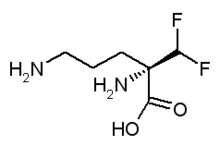(eflornithine cream, 13.9%, Bristol-Myers Squibb and Gillette)
A topical prescription treatment for reducing unwanted facial hair in women.
* Dosage: A thin layer applied to affected areas twice a day at least 8 hours apart. Other hair removal techniques continue to be used as needed.
* Special Considerations: In trials, the most common side effects associated with eflornithine were minor skin irritations such as temporary redness, folliculitis, stinging, or rash, which were mild and "generally resolved without treatment, according to Bristol-Myers Squibb. Because there are no studies in pregnant women, the risk-benefit ratio of using Vaniqa during pregnancy "should be weighed carefully with serious consideration for either not implementing or discontinuing" the use of the product, the labeling says. Not known whether Vaniqa is passed to infants through breast milk.
* Comment: Vaniqa (pronounced VANN-i-ka) inhibits the activity of the enzyme or-nithine decarboxylase, which is found in hair follicles and is involved in hair growth. In two 24-week studies of 594 women, 32% of those treated with Vaniqa had at least "marked improvement" vs. 8% of those treated with a vehicle cream. Those in the treatment group felt significantly less bothered about their facial hair and by the time they spent on removing, treating, or concealing facial hair. The product took up to 8 weeks to have an effect, and within 8 weeks of stopping use women returned to pretreatment levels of hair growth.
Dermatologist Elizabeth McBurney, who has not yet prescribed Vaniqa but is familiar with it, said that one of its advantages is that it works on hair of any color, while hair removal lasers work best on pigmented hair. Thus, Vaniqa should be helpful to those who have gray or white hair mixed in with darker hair, said Dr. McBurney who plans to use it in conjunction with laser hair removal. "The disadvantages are that it has to be put on twice a day, it doesn't work overnight, and ... you have to keep using it" to maintain the effect, added Dr. McBurney of Tulane University and Louisiana State University, New Orleans.
The cream has been studied only for reducing hair on the face and areas under the chin, but Dr. McBurney, who has no financial ties to the manufacturers, said that she would prescribe it for reducing hair growth on other parts of the body such as the axilla or legs. She would also advise patients to test a small area of the skin first for an allergic reaction.
COPYRIGHT 2000 International Medical News Group
COPYRIGHT 2001 Gale Group



